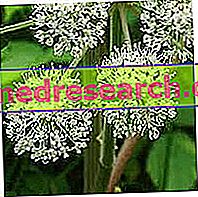By Dr. Rita Fabbri
 | Botanical name : Angelica archangelica L. ( sin. Angelica officinalis Hoffm . ) Family : Umbrellifere (or Apiaceae) Parts used : Roots |
Botanical description
Angelica is a biennial or perennial herbaceous plant. The erect, robust, hollow and reddish stems can reach two meters in height. The leaves, bright green and up to half a meter long, are petiolate, with a clear sheath that wraps the stem, pinnate, with a serrated edge and lighter green on the lower side. The Angelica can be compared to a giant parsley with stems similar to those of celery. The root is robust and fleshy. The small flowers, between light green and pale yellow, are gathered in large, compact and round umbrellas; Angelica blooms in late summer, the inflorescences have a sweet and warm scent, reminiscent of anise. The fruit is formed by two achenes leaning against each other, of a brownish color with three well-evident dorsal ribs and a short wing of tuberous consistency.
The plants are found in the wet meadows of mountain resorts, on the banks of rivers and in coastal areas. The ideal climate is temperate, the best exposure is the partial shade and the soil must be rich in organic substances and well drained. Angelica generally tolerates both high and low temperatures well.
It can also be used as an ornamental plant: it is advisable to choose a pot suitable for the size and keep the soil always moist.
Angelica is a plant native to northern Europe and Asia. In Europe (Germany, France, Hungary and Belgium) the species cultivated and used for medicinal purposes is the Angelica archangelica . In Italy it grows spontaneously only in some meadows of the Alps and the Apennines, and is often confused with Angelica sylvestris (or wild Angelica).
The main species, Angelica archangelica (or Angelica officinalis ), differs from the sylvest ris which is much less fragrant, smaller in both height and leaf size, the green tone is identical on both pages of the leaf, the flowers are pinkish-white and is not used in the kitchen.
The root is the part of the plant commonly used and is harvested in the fall. You can also use the seeds extracted from the umbrellas in late summer, the stem always picked in summer, and the leaves harvested in late spring.
There are about thirty species of Angelica; among the most important we can remember (Latin name and common name):
- Angelica sinensis or polymorpha (Chinese angelica, dong quai)
- Angelica acutifolia (Japanese angelica)
- Angelica atropurpurea (American Angelica)
- Angelica sylvestris (Wild Angelica)
- Angelica archangelica o officinalis (European Angelica )
Angelica dong quai has always been cultivated as a medicinal plant for various gynecological disorders (dysmenorrhoea, amenorrhea, metrorrhagia, disorders related to menopause, especially hot flushes and as a supplement during pregnancy); for this reason it is often referred to as "female ginseng" (4-6). Later the Japanese Angelica was introduced. The two species seem to have similar phytotherapeutic effects even though China and Japan claim their own as the most effective.
According to some Authors also European and American Angelica would have different therapeutic activities from those in Asia, but this difference has not been scientifically demonstrated. The most common phytotherapic use of American Angelica is in heartburn and colitis associated with symptoms such as pain and abdominal tension, diarrhea, constipation, flatulence, meteorism, swelling and digestive difficulties (7).
Chemical composition
The Archangelica angelica is very rich in coumarins, including ostolo, ostenolo, umbelliferone, angelicina, archangelicina, bergaptene, ostruttolo and other unidentified coumarins.
In the root there are also flavonoids, caffeic acids, tannins, resinous, bitter and sugary substances. Finally, the root contains an essential oil (0.3-1%) rich in monoterpenes, such as α-pinene, β felladrene, limonene and p-cymene, borneol and macrocyclic lactones (4.8). The quantity and quality of the essential oil of Angelica vary in relation to the place of origin of the drug: the plants that grow at great heights (9-10) are richer in oil, therefore more aromatic. The main odorous component of Angelica essential oil is the lactone of 15-oxy-pentadecenoic acid (11-12).
Chinese and Japanese Angelica have a very similar chemical composition and contain coumarins, flavonoids and an essential oil whose aroma is characteristic and different from that of the archangelica.



